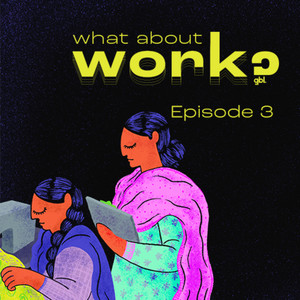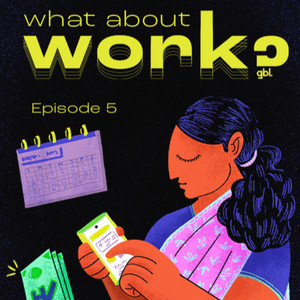In the fourth episode of What About Work? We discuss the financial challenges of women workers in a low-income context. Despite having a steady stream of income, most workers are unable to stretch their incomes till the next pay day, thus facing liquidity constraints which negatively impacts their mental health.
What social and personal factors prevent women employees from stretching their income for a month? What do they do to resolve those financial issues? How can a lack of funds affect them in time of requirement? What decision-making authority do they have over their own hard-earned money? Is it possible to lessen these stressors?
Transcript
Hello! And welcome to What about work? An audio series produced by Good Business Lab.
Good Business Lab seeks to globally transform the lives of low-income workers through rigorous research and evidence-based solutions.
What about work? talks about the past and current experiences of workers in labor-intensive industries and other emerging sectors across geographies. Be it garment, automobile, fast food, platform gig work or any other.
Our last two episodes focused on soft skills. The next two will try to understand what kinds of financial obstacles blue-collar women workers in India experience and what can be done about them. But first I want to ask you a few things.
Do you have a say in how your money gets spent? What happens when there is an emergency and your resources are running low? Who do you turn to? Have you ever felt stressed about money?
Many of us have, at some point.
A 2021 report by the Pew Research Center showed how financial anxieties can negatively impact mental health. They can also increase the likelihood of developing serious chronic health conditions. Financial security is a crucial part of a person’s wellbeing.
So how would this translate to women workers in low-income contexts? What decision-making power do they have when it comes to their own hard-earned money? What decisions do they then choose or are forced to make? And is there any way to reduce these stressors?
Simranjeet Dhir, Research Manager at Good Business Lab, weighs in.
Simranjeet D: So most of the low income households face a very common problem of consumption smoothing, which is essentially a practice of evenly distributing or spreading one’s consumption over a period of time.
We all have expenses that we plan for in advance. Bills we know that in the span of a month need to be paid. Maybe it’s housing, electricity, gas, food and groceries, or other mandatory expenditures. But there are often things that could crop up and put a dent in your income.
Apoorv Somanchi is a Research Associate at Good Business Lab. Along with Simranjeet and other voices you will hear today, Apoorv was part of research conducted in India’s garment sector that looked at the financial wellbeing of women factory workers. The surveys were designed to understand their ability to stretch incomes over the period of a month.
Apoorv S: I think the biggest common shock in both the surveys was say a medical emergency or a sudden school payment that needs to take place.
Simranjeet: These households are not able to manage the amount of income they get versus the amount of expenditure they have to make.
A health emergency doesn’t just involve medical expenses. It can also mean having to spend money, that you might not have, traveling to and fro from the site of treatment, or the dispensary, if these are not located nearby. That also could mean possibly taking time off work and losing more money from that if your employer didn’t provide you with paid leave that day.
Shaila M is a Field Analyst at Good Business Lab. She remembers a worker telling her
Shaila M: Now if someone passes away in our house, then we have to borrow money just to go back to our homes. One thousand or even more than that sometimes. It is very difficult for us. Any unexpected function or anything. After we have spent the money, we cannot even afford a bus pass. We walk and go to work or there are delays in bringing the ration or [other] thing[s].
Things like this can make it hard for low-income families to stretch their incomes to the end of the month. Forget being able to accumulate any savings at all. This is true for many blue-collar women workers.
There’s a saying that it’s expensive to be poor. One illness, one leaky pipe, one spike in gas prices and you can see money going down the drain. I mean, we all experienced it during the pandemic. Unexpected shocks. They can really take your earnings for a spin. A paper by the International Monetary Fund explained how low-waged workers in Vietnam, Cambodia, and Nepal were less likely to stretch incomes easily or ‘smooth consumption’ as Simranjeet said, when faced with negative income shocks.
But it’s important to understand women workers as a heterogeneous group. There are as many pressures as there are workers on a factory floor. They can come from different backgrounds and have different responsibilities and commitments.
Here’s Good Business Lab’s Field Associate Sneha Palekar with more on this.
Sneha P: Concerns are different from demographic to demographic, you know, married women to widowed women, to separated women. I would say from the interviews that I sat for or I observed it’s all like a very mixed group. So mostly this unmarried women, they would say that, ok, we get the salary and then we send like around more than half of it to our family and then we’ll keep a little bit for, for our daily expenses over here.
Good Business Lab’s Co-founder and Chief Strategy Officer, Anant Nshyadham, also an Assistant Professor at the University of Michigan adds that,
Anant N: We tend to see that these women commit their incomes back to their households maybe even more. So if they are a primary source of income for their households, they do it right after they get their paycheck. You can imagine that these women overweight that decision about how much to send home. but then underestimate in their decision making, their future selves, desperation or feelings of scarcity and the kind of distress that it puts on them. So they send that money early and then kind of find themselves in need later on. But what we know is that there is substantial distress then that comes from this.
But, regardless of her marital status, the money a blue-collar woman worker brings in is often not seen as being hers. Something that isn’t always the case for men, married or unmarried.
Apoorv S: We also have anecdotal evidence from our qualitative research as well as like I said, from some of our ongoing data exercises right now that men in the household do tend to make personalized expenses without accounting for say family budget and so on. Interestingly, a very seminal paper by Nava Ashraf also showed that when women control household savings, men are more likely to keep money for themselves when they don’t have to reveal what they do with their money. And so there is this tying back to the point that I made earlier, which is that men tend to make private consumption their priority.
And this matters. It might deplete a household’s ability to spend.
At some point families do have to raise money from sources other than their salaries to meet their needs. Are all women then in an environment where they can make these decisions? And if so, what decisions do they make?
Anant N: We’ve done qualitative work and we kind of asked them, you know, suppose you needed to get ₹5000 together for some medical emergency or some emergency that you needed money for. Two thirds said they could raise the money in like 30 days time, but only one in 10 said they could raise this money in a week’s time. and one in four said they could try to dip into their savings. So that shows a substantial constraint here that, very few could come up with that amount of funds, which is less than a month’s pay. And there are many examples of expenditures that are of that magnitude and might need to be paid in that shorter time and 30 days is too long. You know, they can take formal loans but they’re not that common.
Simranjeet D: Women also have had low access to financial services like access to bank accounts, access to formal credit and savings instruments due to a lot of social and structural constraints.
Several studies have shown how people in low-income contexts largely depend on informal loans rather than loans from banks or financial institutions to meet their needs.
Anant N: What we find is if your friends and family, your social network from your native place, or your friends in the workplace or coworkers cannot provide that sum of money, which can happen, especially in the short run and for large sums of money, you might turn to a money lender to give you a loan that’s not heavily regulated and often has a really high-interest rate.
And those high-interest rates and continual shocks draining their resources can easily trap people into cycles of borrowing. They end up having to borrow money just to pay back old loans.
Both the shocks and the loans can prove especially stressful. Sometimes relatives make rude remarks about pending loans. Sometimes the amount to return gets arbitrarily raised by moneylenders.
But loans aren’t the only way low-income families deal with crises. Selling assets or any property they might own- no matter how small, is another method. In the second wave of COVID-19, data from southern India showed that 25% more old gold than usual was sold to jewelers.
But who makes these decisions? That too can differ widely based on a household’s context.
Apoorv S: So what we see in these households is that there are two crucial aspects around which bargaining power sort of is dictated or revolves around. And that’s primarily to do with their marital status or the age of the woman in question. This was something that was very interesting for us to see because at the very outset, we didn’t think these two things would alter some of this as much as it did.
A recent survey of working women across India conducted by Tata AIA Life Insurance found that 59% do not take independent financial decisions. Less than half said that they had an understanding of financial planning. But of this only 12% were working as homemakers. Engaging in paid work can improve women’s ability to make household financial decisions. But as the 59% number tells us, that isn’t the complete story.
Apoorv S: Interestingly in the case of unmarried women, you know, while their earnings would be considered their own, they would play a very minute role in decision making because a lot of it would be pushed to the head of the household or would just be taken control of by the head of the household. So even when it came to shocks, unmarried women would often say that they rely on their parents or they rely on their brother, if that’s the head of the household and so on to deal with it rather than them having to personally sort of mobilize those resources.
Sneha P: Again, in certain places, there will be involvement of, brother or husband’s brother or husband’s father, somebody like that. But again, most of the time it so happens that once they are widowed, they go back to their own house, they don’t really stay with the in laws. But then single parent, single mother, separated women, if they’re not living with like a big family then the decision making falls on them and they do have a lot of say in the decisions. Again, one more thing we have to keep in mind is that, you know, these women have also have like young kids. Once the kids are older and if the kids are male boys, they will also start taking an active role in decision making, then they actually kind of push their mother’s decision aside. And let’s say that our workers have a, you know, fortunately have like good husband, good family or it’s just the husband, the worker and two children, staying with them. In that case, the husband and wife together, take decisions. She will have a lot of say in the decisions and everything.
Making decisions about how and when finances are distributed is an important ability to have in your own home. And sometimes it can also impact a family’s wellbeing.
Apoorv S: If you look at some studies that have been done in Mexico wherein they shifted the cash transfer to the woman, what we saw was there was an increase in the budget being spent on children’s clothing and children’s food. So there is a shift towards greater nutrition and there is a shift towards prioritizing the child when the female is the recipient of this cash transfer. Another study in Tanzania saw that, you know, providing improving bargaining power of women, sort of led to greater gender equality when it came to the division of resources within a house amongst Children.
But Apoorv also cautions against forming too simplistic a conclusion from these trends.
Apoorv S: Interestingly, Esther Duflo, in her paper in 2012, sort of argued that the usual depiction of women as always being the best decision makers for the long term is somewhat exaggerated. So I think we do have to take this with a little bit of a pinch of salt.
The paper argues that while gender equality and economic development are closely connected, they are not, as Duflo states “the magic bullet they are made out to be” for each other. Improvements in one doesn’t necessarily impact improvement in the other.
But what one can possibly take away is that if men, as we heard earlier, make private consumption a priority or take financial decisions without consulting women, and if families keep experiencing shocks then decreased resources and gendered attitudes force women to forego their own wellbeing and primarily spend money on household expenses. Even groups of blue-collar women workers who have sole decision-making power like single women, widowed women, or divorced women, end up prioritizing those around them and sacrifice their own needs or wishes.
And this isn’t always something to be understood in a positive sense.
We know that in many places around the world, girls and women already eat last in families. But when experiencing acute distress, women also eat the least. A World Food Program study found that in Uttar Pradesh, a state in northern India, one-fourth of the women surveyed had to reduce their portion size as food fell short and they could not afford to buy more. This, along with other factors, can and does lead to an increase in health problems. While only 23% of men in India have iron deficiency anemia, this number jumps to 53% for women. And the fact that women may spend less on their own health than their family’s doesn’t make these conditions any better.
In short, blue-collar women hold up a heavier roof with fewer hands to help.
Our next episode will attempt to answer what could transform this. How can improving their ability to smoothen consumption further women’s wellbeing? Can access to better financial services aid in this? Are innovative interventions possible to implement in labor-intensive settings? The episode will feature researchers and workers sharing their thoughts on these and other questions. So don’t forget to tune in to episode 5!
Thank you for listening to What about work?.
We always welcome constructive feedback. Have anything you want to say? Drop us a message @goodbusinesslab on Twitter, Instagram, or LinkedIn. You can also visit our website goodbusinesslab.org to learn more about our approach to worker wellbeing.




